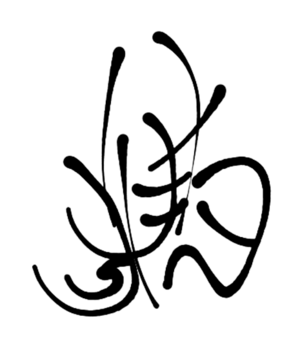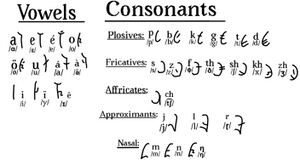Moshurian: Difference between revisions
Jukethatbox (talk | contribs) No edit summary |
Jukethatbox (talk | contribs) |
||
| Line 40: | Line 40: | ||
==Phonology== | ==Phonology== | ||
===Orthography=== | ===Orthography=== | ||
[[File:Moshurian-alphabet.jpeg|300px|thumb|right|The Moshurian script.]] | |||
Moshurian has its own script, who's origin is heavily debated. The general consensus is that it developed from Hátuli script which in itself probably developed from Kutic cuneiform, although some prominent alternate theories include a possible link to [[Proto-Yeldhic]] runes. Some have said the script originates in [[Proto-Taskaric]] record-taking which probably arrived during the Oalanii Period. Some have said that the shape of some plosive characters corresponds with the symbol for "blood" in the logographic orthography of Ancient Izhkut, which was pronounced ''gúp''. | |||
===Consonants=== | ===Consonants=== | ||
Revision as of 11:21, 6 October 2023
| Moshurian | |
|---|---|
| uthilikh | |
 The Moshurian endonym(uthilikh) written in Moshurian script. | |
| Pronunciation | [uðˈilix] |
| Created by | Jukethatbox |
| Setting | Radael |
| Native to | Moshurian Empire |
| Native speakers | ~450,000,000 (400 UH) |
Yeldhic
| |
Early forms | Kóftąbriác Yeldha
|
Standard form | Taráhus Moshurian
|
Dialects |
|
| |
| Official status | |
Official language in | Moshurian Empire Iśatúr Confederacy |
Recognised minority language in | Eastern Gegfen Alliance |
| Regulated by | Ministry of Linguistic Regulation |
Moshurian(uthilikh) is a Týbric language spoken in mostly Talkoch. It is the most spoken language in Talkoch, and also has significant minority communities on Etzeán Island and the Eastern Gegfen Alliance, also called the Dmuriékh(lit. "far away east"). It is the sole official language of the Moshurian Empire, and is thoroughly used administratively and academically in the Moshurian Empire, no matter what one's mother tongue is.
Their exonym of Moshurian comes from a nomadic legend of the god of travel and nomads, Dündŵęk, who traveled to Tuloor Lake(the homeland of the Moshurians) in search of an inn to rest. The Moshurians had plenty of inns(möşhüř as they are called in Ancient Yeldha), and Dündŵęk was finally able to rest. After departing, he thanked the Moshurians, and later mentioned them to the other gods as simply möşhüřiànöřmà, or "inn people". This exonym stuck within nomadic circles, who then passed the exonym to the more settled peoples of Talkoch.
Phonology
Orthography
Moshurian has its own script, who's origin is heavily debated. The general consensus is that it developed from Hátuli script which in itself probably developed from Kutic cuneiform, although some prominent alternate theories include a possible link to Proto-Yeldhic runes. Some have said the script originates in Proto-Taskaric record-taking which probably arrived during the Oalanii Period. Some have said that the shape of some plosive characters corresponds with the symbol for "blood" in the logographic orthography of Ancient Izhkut, which was pronounced gúp.
Consonants
Vowels
Prosody
Stress
Phonotactics
Morphophonology
Morphology
Verbs
Verbs in Moshurian are inflected by default with the infinitve suffix -omh, and then the root of the verb (e.g. dáfhér in dáfhéromh, to eat) is inflected with a different suffix depending on the pronoun.
| Singular | Plural | |
|---|---|---|
| Infinitive | -omh | - |
| First person | -ék(-ïk) | -ékeŋ(-ïkeŋ) |
| Second person | -ót | -(o)tuŋ |
| He | -eź | -iŋź |
| She | -aş | -aŋéş |
| They | -iş | -éiméş |
Syntax
Constituent order
Moshurian uses an OSV(object-subject-verb) sentence structure, such as in the sentence sö kél mosok dáfhéréiméş(grass PL cow eat-3PL), or "cows eat grass".
